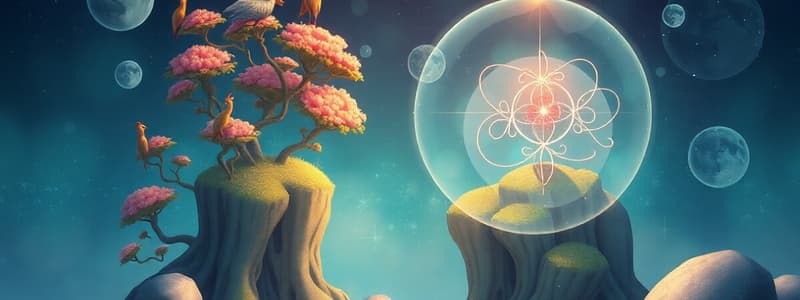Podcast
Questions and Answers
What is the main advantage of sexual reproduction?
What is the main advantage of sexual reproduction?
- Does not require gametes
- Occurs rapidly
- Produces genetically identical offspring
- Increases genetic diversity (correct)
Asexual reproduction involves the fusion of male and female gametes.
Asexual reproduction involves the fusion of male and female gametes.
False (B)
What is the process called that produces gametes via meiosis?
What is the process called that produces gametes via meiosis?
Gametogenesis
The offspring produced by asexual reproduction are genetically ________ to the parent.
The offspring produced by asexual reproduction are genetically ________ to the parent.
Match the following types of reproduction with their descriptions:
Match the following types of reproduction with their descriptions:
Which of the following is a method of asexual reproduction?
Which of the following is a method of asexual reproduction?
Internal fertilization is more common in aquatic animals than in terrestrial animals.
Internal fertilization is more common in aquatic animals than in terrestrial animals.
_____ involves the outgrowth of a new individual from the parent organism.
_____ involves the outgrowth of a new individual from the parent organism.
Flashcards
Asexual Reproduction
Asexual Reproduction
A type of reproduction where a single parent produces offspring that are genetically identical to itself. This process doesn't involve the fusion of gametes (sex cells).
Binary Fission
Binary Fission
The simplest form of asexual reproduction, where a single cell divides into two identical daughter cells.
Budding
Budding
A type of asexual reproduction where a new individual grows out from the body of the parent organism.
Fragmentation
Fragmentation
Signup and view all the flashcards
Vegetative Propagation
Vegetative Propagation
Signup and view all the flashcards
Sexual Reproduction
Sexual Reproduction
Signup and view all the flashcards
Fertilization
Fertilization
Signup and view all the flashcards
Gametogenesis
Gametogenesis
Signup and view all the flashcards
Study Notes
Asexual Reproduction
- Asexual reproduction involves a single parent producing offspring that are genetically identical to the parent.
- This process does not involve the fusion of gametes (sex cells).
- Common methods include binary fission, budding, fragmentation, and vegetative propagation.
- Binary fission is a simple division of the cell into two genetically identical daughter cells. This method is common in prokaryotes like bacteria and archaea.
- Budding involves the outgrowth of a new individual from the body of the parent. Observed in some yeasts and hydra.
- Fragmentation occurs when a piece of the parent organism breaks off and grows into a new individual. Common in some worms and starfish.
- Vegetative propagation refers to the asexual reproduction of plants from vegetative parts like stems, roots, or leaves. This method is used in agriculture to quickly produce identical copies of desirable traits.
Sexual Reproduction
- Sexual reproduction involves two parents producing offspring that are genetically unique.
- It involves the fusion of male and female gametes (sperm and egg).
- This fusion creates a zygote, which develops into a new individual.
- Sexual reproduction increases genetic diversity through recombination of genetic material from both parents.
- Advantages of sexual reproduction include adaptability to changing environments due to variation and the ability to repair genetic damage.
- Different life cycles exist, varying significantly between species in the timing and proportion of haploid and diploid stages.
- Gametogenesis is the process of producing gametes via meiosis. The male gamete is the sperm, and the female gamete is the egg.
- Meiosis produces haploid gametes, halving the number of chromosomes compared to the parent.
Fertilization
- Fertilization is the fusion of male and female gametes to form a zygote.
- External fertilization occurs outside the body of the female, typically in aquatic environments. Eggs and sperm are released into the water, where fertilization takes place.
- Internal fertilization occurs inside the body of the female. This method protects the developing embryo and is common in land animals.
- Fertilization can be internal or external.
- Internal fertilization is more common in terrestrial animals, providing protection for the developing embryo.
- External fertilization is more common in aquatic animals.
Development
- Development is the series of changes that occur from a fertilized egg to a mature organism.
- It involves cell division, differentiation, and morphogenesis.
- Cell division is the increase in the number of cells.
- Differentiation is the specialization of cells into various tissue types (muscle, nerve, etc.).
- Morphogenesis is the creation of body form and organization.
- Different patterns and stages of development exist across various species.
- Early embryonic development is characterized by rapid cell division and cell migration.
- Different species have diverse reproductive strategies and developmental processes, reflected in the wide range of animal and plant forms.
Studying That Suits You
Use AI to generate personalized quizzes and flashcards to suit your learning preferences.




